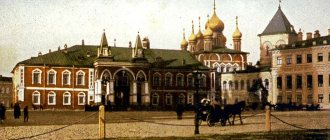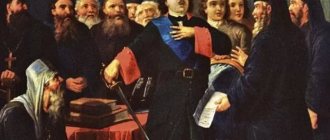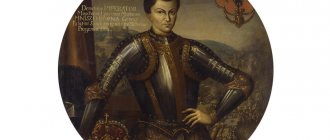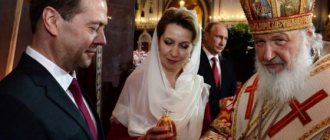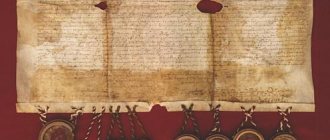Alexy II
On February 23, 1929, Alexy II, Patriarch of Moscow and All Russia, was born.
Private bussiness
Alexy II (in the world - Alexey Mikhailovich Ridiger, 1929-2008) was born in Tallinn in the family of Archpriest Mikhail Ridiger. A major role in introducing the boy to church service was played by the rector of the Koppel St. Nicholas Church in Tallinn, in which Mikhail Ridiger served as a deacon. Already at a young age, Alexey became an altar boy in this church.
Alexey’s desire to become a priest appeared, according to him, already in his early adolescence. At the age of fifteen he became a subdeacon of the Archbishop of Narva (later of Tallinn and Estonia) Pavel (Dmitrovsky), after which he served as an altar boy and psalm-reader in various Tallinn cathedrals.
In 1947 he entered the Leningrad Theological Seminary immediately in the third grade, and after graduating in 1949 he became a student at the Theological Academy in Leningrad. In April 1950 he was ordained deacon; two days after this, he was promoted to presbyter and appointed rector of the Epiphany Church in the Estonian city of Jõhvi, Tallinn diocese.
In 1953 he graduated from the Leningrad Theological Academy, receiving the title of candidate of theology. In July 1957 he was transferred to Tartu, where he served first as rector of the Assumption Cathedral, and from March 1959 as dean of the united Tartu-Viljandi deanery of the Tallinn diocese. In 1958 he was elevated to the rank of archpriest.
In August 1959 he decided to become a monk. On March 3, 1961, at the Trinity-Sergius Lavra, he was tonsured with the name Alexy. In August of the same year, he was appointed Bishop of Tallinn and Estonia and elevated to the rank of archimandrite. He served as diocesan bishop at the Tallinn See for a quarter of a century - until 1986.
After tonsure, he began to conduct active foreign policy and ecumenical activities: as part of the delegation of the Russian Orthodox Church, he participated in the work of the III Assembly of the World Council of Churches in New Delhi (1961); elected member of the Central Committee of the WCC (1961-1968); was president of the World Conference on Church and Society (Geneva, 1966). As the head of the delegation of the Russian Orthodox Church, he participated in theological interviews with delegations of various Evangelical churches. He was a delegate and one of the presidents of the 1983 World Christian Life and Peace Conference in Sweden.
In addition to church ones, Alexy took part in the work of secular international and Soviet public organizations. He was a member of the Board of the Soviet Peace Foundation, a member of the Board of the Foundation of Slavic Literature and Slavic Cultures, a member of the Board of the Soviet Charity and Health Foundation, a member of the Presidium of the Leningrad Cultural Foundation, and vice-president of the Society of Soviet-Indian Friendship. He was a participant in the founding meeting of the Rodina Society and a member of the Society’s council from 1975 to 1987.
Already from the beginning of the 60s, Alexy began to make a fast career in the central structures of the Moscow Patriarchate. In 1961, he was included in the delegation of the Russian Orthodox Church MP of the Rhodes Pan-Orthodox Conferences, and was appointed deputy chairman of the Department for External Church Relations (DECR) of the Moscow Patriarchate.
In June 1964, he was elevated to the rank of archbishop and a month later he was appointed Administrator of the Moscow Patriarchate and, ex officio, a permanent member of the Holy Synod. In February 1968 he was elevated to the rank of metropolitan.
He was a member of the Holy Synod Commission for the preparation of the Local Council of 1971, as well as chairman of the procedural and organizational group, chairman of the secretariat of the Local Council. He was deputy chairman of the commission for preparing and holding the celebration of the 1000th anniversary of the Baptism of Rus'. In 1984 he received the title of Doctor of Theology, his dissertation was a three-volume work “Essays on the History of Orthodoxy in Estonia.”
In July 1986 he became Metropolitan of Leningrad and Novgorod and a permanent member of the Holy Synod.
For more than a quarter of a century he was an employee of the staff, and later one of the presidents (members of the presidium) of the Conference of European Churches (CEC).
After the death of Patriarch Pimen in 1990, he was elected Patriarch of Moscow and All Rus' by the Local Council. Alexy scored 166 votes, beating Metropolitan of Rostov and Novocherkassk Vladimir (Sabodan) by 23 votes. On June 10, 1990, the enthronement (enthronement) of Alexy II took place in the Moscow Epiphany Cathedral.
In the last years of his life, the Patriarch suffered from coronary heart disease, suffered several heart attacks and repeatedly traveled abroad for examination. His last public service was held on December 4, 2008, on the feast of the Entry of the Blessed Virgin Mary. He died on December 5, 2008 at his residence, near the village of Peredelkino. According to the official version, the cause of death was acute heart failure.
Alexy II was buried in the southern (Annunciation) aisle of the Epiphany Cathedral.
Patriarch Alexy II
What is he famous for?
His Holiness Patriarch Alexy II was the fifteenth primate of the Russian Orthodox Church. His election took place shortly before the collapse of the Soviet system. After the collapse of the USSR, the patriarch managed to establish contact with the country's leaders. Russian President Boris Yeltsin became the first post-Soviet leader to cross the threshold of the temple.
Over the 18 years during which Alexy II held the post of primate of the Russian Orthodox Church, it significantly strengthened its position.
In the 1990s, the state began to provide active, including financial, assistance to the Russian Orthodox Church in the restoration of churches, the development of spiritual education, pastoral care in government departments, in the army, in prisons, etc. There was a steady increase in the number of parishes, monasteries, educational institutions.
If at the time of Alexy’s election as patriarch the Russian Orthodox Church included 35 monasteries and a little more than 8,000 clergy, then by the time of his death the number of monasteries exceeded 800, and clergy exceeded 30,000 people.
And although complete restitution of pre-revolutionary church property did not occur, the surviving churches were transferred to the church for free use, and a number of large churches were built with funds from regional budgets and large companies. and the construction of the Cathedral of Christ the Savior took place with strong financial support from the state.
“I had to establish a completely new relationship between the state and the Church, which had not existed in the history of Russia, because the Church was not separated from the state, the emperor was the head of the Church, and all decisions that were made on church issues came from his office. And now a completely new relationship has been established, when the Church itself makes decisions and is responsible for its actions before its conscience, history, and people,” said Alexy II in his last interview, given on November 1, 2008 and published posthumously.
What you need to know
In the 1990s, material became public about a certain agent “Drozdov,” recruited by the KGB in February 1958 “on patriotic feelings to identify and develop an anti-Soviet element from among the Orthodox clergy.” According to the responsible employee of the Estonian State Archive, historian Indrek Jürjo, details of the biography of an agent named Drozdov, found in the KGB annual report for 1958, correspond to the Estonian origin, year of birth, education and career path of Ridiger Alexei Mikhailovich, while time of the parish priest.
According to research by Christopher Andrew and Vasily Mitrokhin, in 1975, Alexei Ridiger founded the Rodina society, which served as a cover organization for the activities of the KGB. Publications about Drozdov’s cooperation with state security agencies were based on documents from the KGB archives, to which official access was obtained by a number of individuals at the end of 1991.
On September 20, 2000, DECR employee Vsevolod Chaplin refuted the allegations of cooperation with the KGB, in connection with which the British research organization Keston College published the conclusions of its analysis of the documents at its disposal: “Allegations that the Patriarch and other high-ranking bishops of the Russian Orthodox Church collaborated with KGB, based on reality."
Officially, information about Alexey Ridiger’s intelligence cooperation with the KGB was never confirmed by the state security agencies of the Russian Federation or the USSR.
Direct speech
“This choice was not easy, because we clearly understood that the path of pastoral service in Soviet times was not easy. My parent was already a priest. But, despite all the difficulties of this path, which I knew about, seeing my father’s ministry, I was not tempted to take a different path. And as soon as the opportunity to receive a theological education presented itself, I took advantage of it. I was sure that I should only become a priest,” Alexy II. Interview to the newspaper "NG-Religions"
“Patriarch Alexy II had an incredible career during which he switched from suppressing the Russian Orthodox Church to being its champion. A favorite of the KGB, he quickly rose through the church hierarchy, following the Kremlin's orders at a time when dissident priests were being jailed. As the Church's de facto foreign minister, he helped cover up the repression of Russian Christians while defending the Soviet system to the outside world. He rose quickly and was elected head of the Russian Orthodox Church at a key moment in 1990, as the USSR was approaching its collapse. Surprisingly, it is likely that he took advantage of the moment and became the head of the revival and prosperity of the Church,” Double life of Russia's patriarch. BBC
“Patriarch Alexy II became <...> the first representative of the church who managed to bring together the interests of religious and state authorities so much that it became impossible to separate one from the other in the future,” Kommersant. The patriarch gave his soul to God.
“Alexy II led the Russian Church from Babylonian captivity, that is, from the Soviet Union, into a new life,” Archbishop Mark.
5 facts about Alexia II
- During his tonsure, Alexy Ridiger was named Alexy in honor of another saint: not Alexy, the man of God, whose name he was named in baptism, but Alexy, Metropolitan of Kyiv, Saint of Moscow.
- Alexy II became the first Moscow Patriarch to use a number in his name (although in historiography it is customary to call the 17th century patriarchs Joasaph I and Joasaph II, numbers were not used in that era).
- In 1989, when he was Metropolitan of Leningrad and Novgorod, Alexy was elected people's deputy of the USSR from the public organization Health and Mercy Foundation. He was a member of the Commission of the Council of Nationalities on the development of culture, language, national and international traditions, and the protection of historical heritage.
- During the period of the primacy of Alexy II, Local Councils were not convened even once, although the Charter of the Russian Orthodox Church, in force until 2000, determined that the Local Council should be convened at least once every five years.
- The farewell ceremony for the newly deceased patriarch took place in the Cathedral of Christ the Savior from December 6 to 9. The temple was open around the clock. According to the press service of the Moscow City Internal Affairs Directorate, more than 100,000 people came to say goodbye to the patriarch.
Materials about Alexy II
Alexy II. Biographical article on the official portal of the Moscow Patriarchate
Interview of His Holiness Patriarch of Moscow and All Rus' Alexy II to the newspaper “NG-Religions”. February 24, 1999
Mikhail Sitnikov “Priest. Secret agent"
The patriarch gave his soul to God. Newspaper "Kommersant" No. 223 dated December 6, 2008
The patriarch's childhood
In the world he is Alexey Mikhailovich Ridiger. He was born on February 23, 1929 in the Estonian city of Tallinn. The family of the future Patriarch was deeply religious. Alexey's father, Ridiger Mikhail Alexandrovich, was a native of St. Petersburg and came from an old St. Petersburg family. The Saint's mother, Elena Iosifovna Pisareva, was Estonian.
Life of Russian families in pre-war Europe. who emigrated from their homeland was not very wealthy. But although material life was meager, this did not prevent His Holiness from developing culturally.
The best article for you, go to: Icon of Spyridon of Trimifuntsky, what helps and meaning
From a young age, the boy strove for worship. The spirit of Orthodox churchliness has always reigned in the family of the High Hierarch. It has always been believed that the temple and family are an inseparable part. That is why for young Alexei there was no question of choosing a path in life.
At the age of six, the boy took his first conscious steps in an Orthodox church. He acted as the priest's assistant, pouring out the sacred water. Then he definitely decided that when he grew up, he would become a clergyman.
The beginning of the priestly path
In 1957, Father Alexey became rector of the Epiphany Monastery of the Cathedral of the Assumption of the Virgin. In 1958, Archpriest Ridiger, who led two monasteries, was appointed dean over several parishes.
After the death of his mother, who went to the Lord on the bright feast of the Transfiguration of the Lord, in 1959 Alexey Ridiger took monastic vows with the name Alexy.
In the same year, the future Patriarch was tonsured into the mantle, accepting the minor schema, renouncing worldly life with complete obedience to the bishop and non-acquisitiveness, which implies the absence of one’s own property.
Interesting! In 1961, 32-year-old Father Alexy became the youngest archpastor of the Russian Church, having been ordained as a bishop.
The Bishop of Estonia and Tallinn is appointed to the Diocese of Riga.

